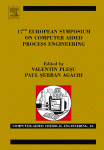 Authors: William BARRETT¹, Michel PONS, Lars von WEDEL², Bertrand BRAUNSCHWEIG³
Authors: William BARRETT¹, Michel PONS, Lars von WEDEL², Bertrand BRAUNSCHWEIG³
Affiliation(s):
¹US Environmental Protection Agency, 26 W Martin Luther King Drive, Cincinnati, OH 45268,USA
CO-LaN
²AixCAPE e.V., Turmstrasse 46, 52064 AACHEN, GERMANY
³Institut Français du Pétrole, 1 &4 avenue de Bois Préau, F-92500 Rueil Malmaison, France
Reference: Computer Aided Chemical Engineering, Volume 24, 2007, Pages 165–170
Abstract:
The CAPE-OPEN standard interfaces have been designed to permit flexibility and modularization of process simulation environments (PMEs) in order to use process modeling components such as unit operation or thermodynamic property models across a range of tools employed in the lifecycle of chemical process systems engineering. Technical foundations of interoperable software are constantly changing and Microsoft is nowadays declaring .NET and a successor to COM which has been the major platform for numerous CAPE-OPEN components so far. In order to ensure that the CAPE-OPEN idea will be applicable to recent technical changes, the COLaN has gathered experiences in the area of CAPE-OPEN implementations making use of .NET. This paper will demonstrate that CAPE-OPEN can be successfully implemented using .NET development tools and highlight how the CAPE-OPEN development can benefit from these new technologies.
DOI: 10.1016/S1570-7946(07)80051-4
CAPE-OPEN related articles cited in text:
- Barrett, W. M.; Yang, J., Development of a chemical process modeling environment based on CAPE-OPEN interface standards and the Microsoft .NET framework. Computers & Chemical Engineering 2005, 30, (2), 191-201.
- Pons, M. (2003). “Industrial Implementations of the CAPE-OPEN Standard.” AIDIC Conference Series 6: 253-262.
